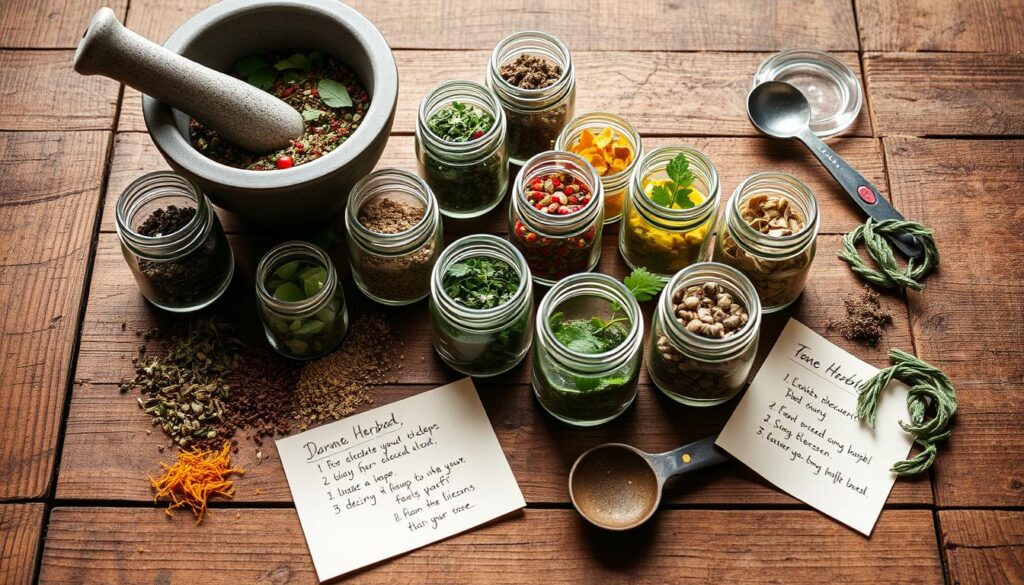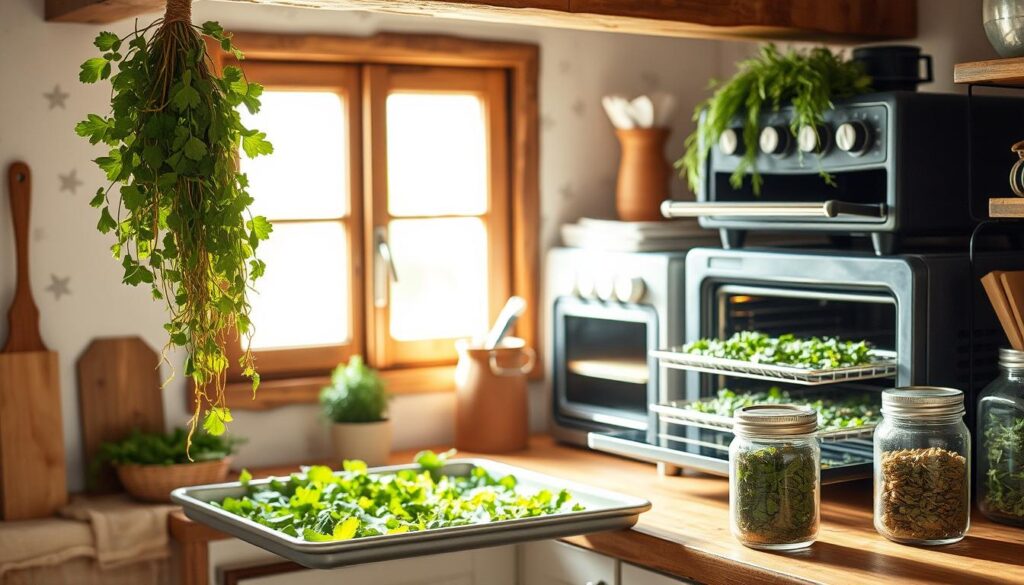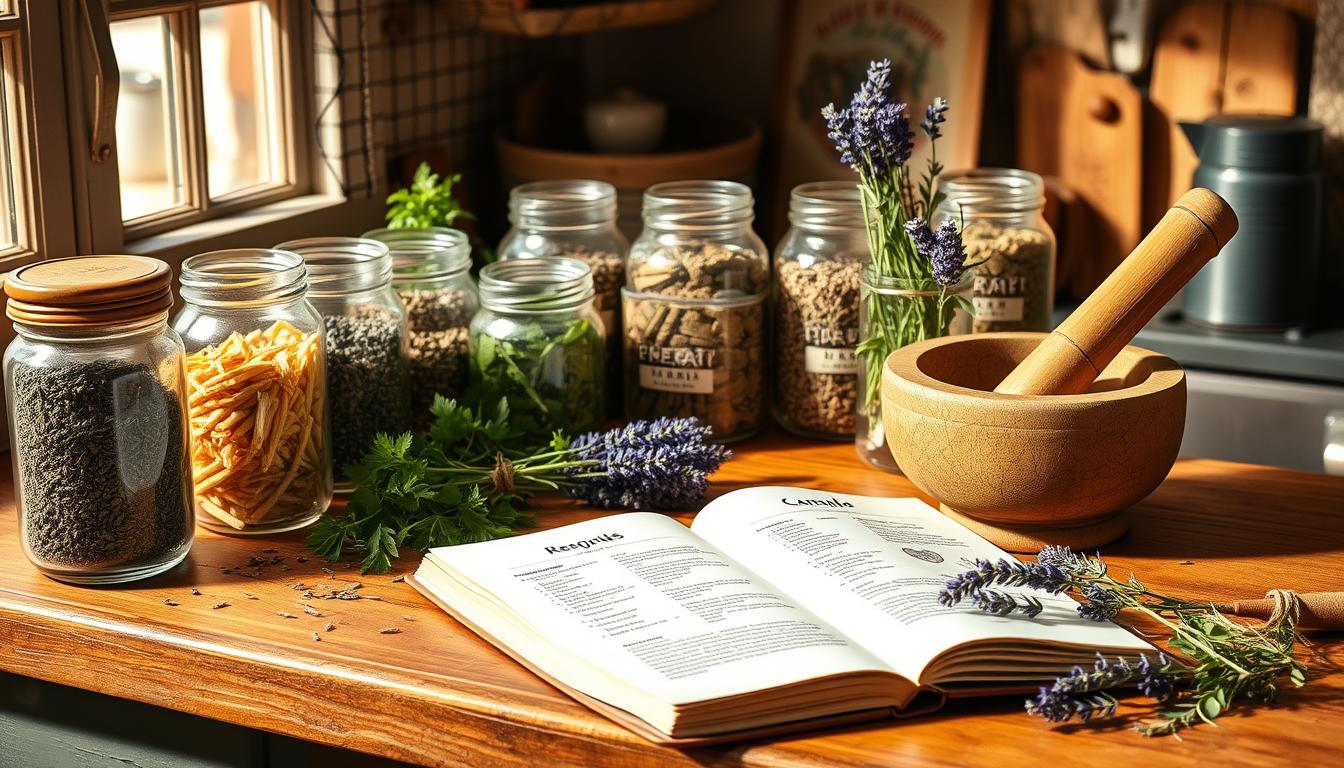Easy Steps to Make Your Own Dried Herb Blend
Ever thought about making your own dried herb mix? It lets you pick the ingredients and flavor for your cooking. You can use fresh herbs from your garden or buy them. It’s simpler than you might think1. Follow a few easy steps to make your own blend and have your favorite herbs ready.
Creating your own dried herb mix means you can tailor it to your liking. It’s great for those who love cooking and want to add a personal touch. This guide will show you how to make your own dried herb blend1.
Key Takeaways
- You can make your own dried herb mix using fresh herbs from your garden or store-bought alternatives.
- The process of making your own dried herb blend is easy and customizable to your taste preferences.
- By making your own diy herbal spices, you can control the ingredients and flavor profile for your cooking and seasoning needs.
- Dried herbs can be stored for up to 6 months in a cool, dry place1.
- Making your own dried herb blend allows you to have the freshest ingredients possible and add a personal touch to your dishes.
- You can use your homemade dried herb mix to add flavor to a variety of dishes, from soups to sauces and more.
Understanding the Basics of Herb Drying
To make your own seasoning blend, you need to know how to dry herbs. Drying fresh herbs makes their flavor and smell stronger2. Herbs like mint, thyme, and rosemary work well for drying. It can take 1 to 6 hours2.
Drying herbs can be done in different ways. Air drying, oven drying, and using a dehydrator are common methods3. It’s also important to store dried herbs right to keep their taste and smell. They can last up to 6 months2 or even 2 years in a cool, dark place3.
Some herbs dry better than others. Herbs like rosemary and thyme with firm leaves are best3. But herbs like basil and parsley, which have soft leaves, can still be used. Knowing how to dry herbs lets you make your own seasoning blend and enjoy herbal infusions all year.
| Herb | Drying Method | Storage Duration |
|---|---|---|
| Rosemary | Air drying, oven drying, dehydrator | Up to 6 months |
| Thyme | Air drying, oven drying, dehydrator | Up to 6 months |
| Basil | Air drying, oven drying, dehydrator | Up to 6 months |
By following these tips, you can make your own seasoning blend. Remember to store your dried herbs well to keep their flavor and smell. Try different drying methods to see what works best for you4.
Essential Equipment for Creating Herb Blends
To make your own herb mix, you’ll need some basic tools. The third source says you’ll need measuring cups and spoons5. These tools help you measure ingredients right and store the mix well, keeping its taste and smell.
For storing your herb mix, airtight containers are key. Use glass jars or containers with tight lids to keep herbs fresh. This is crucial if you plan to store them for a long time5.
Other must-haves for making herb blends include a mortar and pestle, a spice grinder, and a scale. These tools help you measure and mix herbs accurately. With the right tools, you can make many types of herb blends, from simple to complex. This way, you can enjoy fresh, quality herbs in your cooking6.

It’s also vital to think about the quality of your herbs. Fresh, organic herbs will make your mix taste and smell better. You can grow your own or buy them from a trusted supplier7. Using top-notch herbs and the right tools lets you create a mix that suits your taste.
Selecting Quality Herbs for Your Mix
Creating your own dried herb mix starts with choosing the right herbs. You can pick fresh herbs from your garden or buy them8. Make sure the herbs are fresh and consider any allergies. Mixing herbs like basil, oregano, and thyme can give your mix a unique taste.
Buying organic herbs can be just as good as using fresh ones9. Organic herbs often taste better and smell stronger. When drying herbs at home, it’s key to keep their flavor and smell.
Here are some tips for picking quality herbs:
- Choose fresh herbs with no signs of wilting or damage
- Consider the flavor profile you want to achieve with your herb mix ideas
- Store your herbs properly to maintain their freshness and aroma
By using these tips and high-quality herbs, you can make tasty herb mixes. These mixes will make your cooking even better10.
| Herb | Flavor Profile | Usage |
|---|---|---|
| Basil | Sweet and aromatic | Pesto, caprese salad |
| Oregano | Pungent and earthy | Pizza, pasta sauces |
| Thyme | Savory and slightly minty | Soups, stews, meat dishes |
How to Make Your Own Dried Herb Mix: Step-by-Step Guide
To make your own dried herb mix, start by picking fresh herbs like basil, oregano, and thyme11. You can dry them using air drying or the oven11. After drying, mix them in the right amounts to create your blend.
Here are the basic steps to follow:
- Harvest or purchase the fresh herbs
- Dry the herbs using your preferred method
- Combine the dried herbs in your desired proportions
- Store the dried herb mix in an airtight container
By following these steps, you can create your own unique blend, like Mediterranean or Italian seasoning12. You can also try different herb combinations for your own flavors.
Remember to keep your dried herb mix in a cool, dark place12. This helps keep the flavors and aromas fresh. With a bit of practice and patience, you can enjoy homemade herbs all year.
| Herb | Proportion |
|---|---|
| Basil | 1/4 cup |
| Oregano | 2 tbsp |
| Thyme | 2 tbsp |
Different Drying Methods for Various Herbs
Creating your own seasoning blend starts with knowing how to dry herbs. You can make herbal infusions by drying herbs in different ways. Each method is best for certain herbs, based on their moisture and your preference.
Air drying is easy and cheap, taking about a week for herbs like rosemary and thyme13. It’s good for herbs that don’t hold much moisture. Oven drying works better for wetter herbs, like basil and parsley, and takes about 30 minutes13.
Air Drying Technique
Air drying means hanging herbs upside down. This lets flavorful oils move down to the leaves over time14. It can take a few days to a week, depending on how wet the herbs are15.
Oven Drying Process
Oven drying is quicker, baking leaves at the lowest heat until they break apart easily15. It’s best for soft herbs like basil, mint, cilantro, and parsley15.
Dehydrator Method
Dehydrating herbs at 95 degrees for two to four hours makes them dry and crumbly15. This method is great for drying lots of herbs and gives consistent results.

Choosing the right drying method for your herbs lets you make a seasoning blend full of flavor and scent. It’s perfect for making herbal infusions.
Proper Storage Solutions for Herb Blends
Storing your custom herb mix recipe right is key to keeping its taste and smell16. It’s important to use an airtight container. Glass jars with tight lids work well. Keep them in a cool, dark spot, like a pantry or cupboard17.
Keeping your mix in a cool, dry spot is crucial. Avoid direct light and use dark containers with a tight seal17. Some herbs, like cayenne and paprika, stay fresh longer in the fridge17. Make sure they’re not near heat sources like dishwashers or ovens17.
For the best freshness, use airtight containers like glass jars or plastic bags in a dark, cool spot18. Vacuum sealing can also help keep your mix fresh longer18. By using these storage tips, your custom herb mix will stay flavorful and aromatic for a longer time.
| Storage Method | Description |
|---|---|
| Airtight Containers | Glass jars with tight-fitting lids, stored in a cool, dark place |
| Refrigeration | Refrigerating herbs like cayenne, chili powder, and paprika to retain color |
| Vacuum Sealing | Using a vacuum sealer to remove air from plastic bags for optimal freshness |
Popular Herb Combinations for Cooking
Exploring herb mix ideas can be exciting. Drying herbs at home lets you make custom blends. These can add flavor and aroma to many dishes. For instance, Mediterranean blends often have oregano, thyme, and rosemary. They’re great for seasoning veggies, meats, and soups19.
Another favorite is the Asian fusion mix. It usually includes ginger, garlic, and basil. This mix is perfect for stir-fries, noodle dishes, and marinades. Trying out different herb mixes can lead to unique and tasty flavors in your cooking20.
Herb Blend Ideas
- Mediterranean blend: oregano, thyme, rosemary
- Asian fusion mix: ginger, garlic, basil
- American classic combination: parsley, sage, thyme
Knowing about various herb combinations can help you craft your own blends. This adds depth to your cooking. Whether you’re searching for herb mix ideas or tips on drying herbs, there’s plenty of help out there19.

Measuring and Proportions Guide
Creating your own dried herb mix requires understanding measuring and proportions. The third source highlights the importance of these aspects in making your own herb blend. Start with a small amount of each herb and adjust to taste. You can use a recipe as a guide but feel free to experiment and adjust the proportions to your liking.
To make your own diy herbal spices, consider these tips:
- Start with a small amount of each herb and adjust to taste
- Use a recipe as a guide, but feel free to experiment and adjust the proportions
- Consider the flavor profile you want to achieve and adjust the proportions accordingly
When making your own dried herb mix, you can create custom blends tailored to your personal preferences21. This way, you avoid additives like MSG and high levels of salt found in store-bought spice mixes22. By creating your own diy herbal spices, you ensure your blends are free from unwanted additives and preservatives.
Remember, the key to creating a great dried herb mix is to experiment and adjust the proportions to your liking. With a little practice, you can create custom blends that elevate your cooking and add flavor to your favorite dishes.
Common Mistakes to Avoid When Drying Herbs
When making your own seasoning blend, it’s key to avoid common mistakes. These can ruin the quality and taste of your dried herbs. To make great herbal infusions, drying your herbs right is crucial. Many people mess up by not controlling the temperature or storing them wrong23.
Some common mistakes to avoid include:
- Temperature control issues: Drying herbs at too high a temperature can cause them to lose their flavor and aroma23.
- Storage errors: Storing dried herbs in a humid environment can affect the quality of the blend23.
- Timing problems: Drying herbs for too long or not long enough can impact the flavor and aroma of the blend24.
To avoid these mistakes, it’s crucial to understand the optimal drying methods and storage solutions for your herbs. By following the right techniques, you can create a high-quality homemade seasoning blend and enjoy the benefits of herbal infusions24.
Remember, creating a successful homemade seasoning blend requires attention to detail and a understanding of the common mistakes to avoid. With the right techniques and a little practice, you can create delicious and fragrant herbal infusions that will elevate your cooking to the next level23.
| Common Mistakes | Consequences |
|---|---|
| Temperature control issues | Loss of flavor and aroma |
| Storage errors | Affect on quality of the blend |
| Timing problems | Impact on flavor and aroma |
Creative Ways to Use Your Herb Blends
Now that you know how to drying herbs at home and make your own mixes, it’s time to get creative. You can add your herb blends to many dishes, like soups, stews, salads, and marinades25. For instance, mix them with olive oil and vinegar for a tasty salad dressing.
Here are some more ideas for using your herb blends:
- Add them to soups and stews for extra flavor
- Use them as a marinade for meats or vegetables
- Mix them with butter or oil for a flavorful spread
You can also make infused salts, compound butters, or homemade vinaigrettes with your herb blends25. The possibilities are endless. It’s up to you to experiment and find your favorite ways to use them.
Remember to store your herb blends properly to keep their flavor and aroma. With a little creativity, you can enjoy your herb blends all year round. You can also explore new herb mix ideas to make your cooking and dining experiences better.
| Herb Blend | Usage Ideas |
|---|---|
| Mediterranean Mix | Soups, stews, salads, marinades |
| Italian Seasoning | Pasta dishes, pizza, bread |
Troubleshooting Your Dried Herb Mix
Creating a custom herb mix recipe can sometimes come with challenges. Knowing how to troubleshoot can help you fix problems early. This ensures your dried herbs are flavorful and aromatic. Moisture issues, like mold or mildew, can ruin your batch.
To prevent moisture problems, store your herbs in a cool, dry spot. Keep them away from direct sunlight26. Use airtight containers to block moisture. Color changes can happen if herbs are exposed to light or heat. Store them in a dark place and use UV-resistant containers27.
Flavor problems can occur with low-quality herbs or wrong proportions. Use fresh, high-quality herbs and a reliable recipe. These steps will help you make a delicious, fragrant herb mix that enhances your cooking.
Common Issues and Solutions
- Moisture problems: Store herbs in a cool, dry place, away from direct sunlight26.
- Color changes: Store herbs in a dark place, and consider using UV-resistant containers27.
- Flavor issues: Use fresh, high-quality herbs, and follow a tried-and-true recipe.
By following these tips, you can make a top-notch custom herb mix. It will add flavor and depth to your dishes.
Conclusion
Making your own dried herb blend is a fun and rewarding task. It can make your cooking even better. By following the guide in this article, you can make unique herb mixes for your dishes28.
These mixes will add deep, rich flavors to your food28. Plus, dried herbs can last up to three months on a shelf or a year in the fridge or freezer28. This means you can enjoy your creations for a long time.
As you try out different herbs and drying methods28, remember it’s okay to make mistakes. It’s all part of the fun of learning to make your own herb blends. With practice, you’ll find the perfect mixes for your favorite dishes29.
You can use dried herbs instead of fresh in a 1:3 ratio29. This ensures your dishes always have that fresh, herbal taste.
So, what are you waiting for? Start exploring the world of homemade dried herb blends and discover new flavors in your cooking30. With the right techniques and a bit of creativity, you’ll become a true expert at blending herbs30.
FAQ
What is the process for creating a dried herb blend?
To make a dried herb blend, first, you need to get fresh herbs. You can either harvest them or buy them. Then, dry the herbs using your preferred method. Finally, mix the dried herbs in the right amounts to match your taste.
What are the best herbs for drying to make a blend?
Herbs like rosemary and thyme work well for drying. They have firm leaves. On the other hand, soft-leaf herbs like basil and parsley might lose flavor when dried.
What equipment is needed to make a dried herb blend?
You’ll need measuring cups and spoons for your blend. Also, airtight containers are key for storing the dried herbs. This keeps the flavor and aroma fresh.
What are the differences between using garden-fresh herbs and store-bought herbs for a blend?
Garden-fresh herbs often have more flavor and aroma. But, store-bought herbs, especially organic ones, can also be great. Choose herbs based on their freshness and quality for your blend.
What are the different drying methods for herbs, and how do they affect the final blend?
The drying method affects the herbs’ flavor and aroma. Air drying is good for herbs with low moisture. Oven drying is better for herbs with more moisture. Dehydrators are great for drying large amounts of herbs.
How should I store my dried herb blend to maintain its quality?
Keep your dried herb blend in an airtight container. A glass jar with a tight lid is perfect. Store it in a cool, dark place like a pantry or cupboard.
What are some popular herb blend combinations I can try?
Try Mediterranean, Asian fusion, or American classic blends. Mixing different herbs can help you find your favorite flavors.
How do I determine the right proportions for my dried herb blend?
Start with small amounts of each herb. Adjust the proportions to your taste. Use a recipe as a guide, but feel free to experiment.
What are some common mistakes to avoid when drying herbs for a blend?
Avoid drying herbs too hot, storing them wrong, and drying them for too long. Control the temperature, store properly, and watch the drying time.
How can I use my homemade dried herb blend in cooking?
Use your blend in soups, stews, salads, and marinades. It can also flavor vegetables, meats, and grains. Get creative in the kitchen.
How can I troubleshoot issues with my dried herb blend?
If you have moisture problems, color changes, or flavor issues, find the cause. It might be drying or storage problems. Adjust your methods to improve your blend’s quality and flavor.







